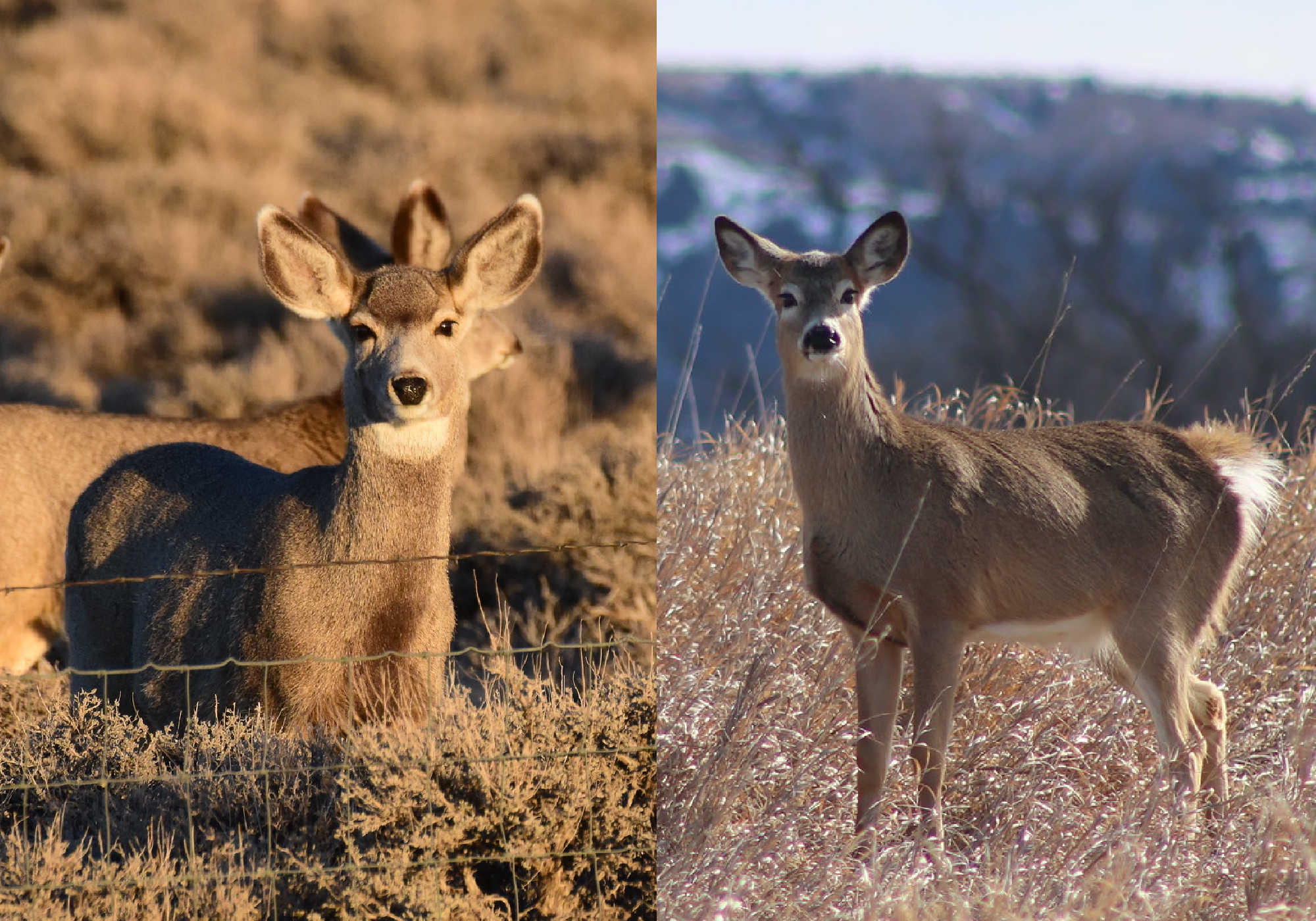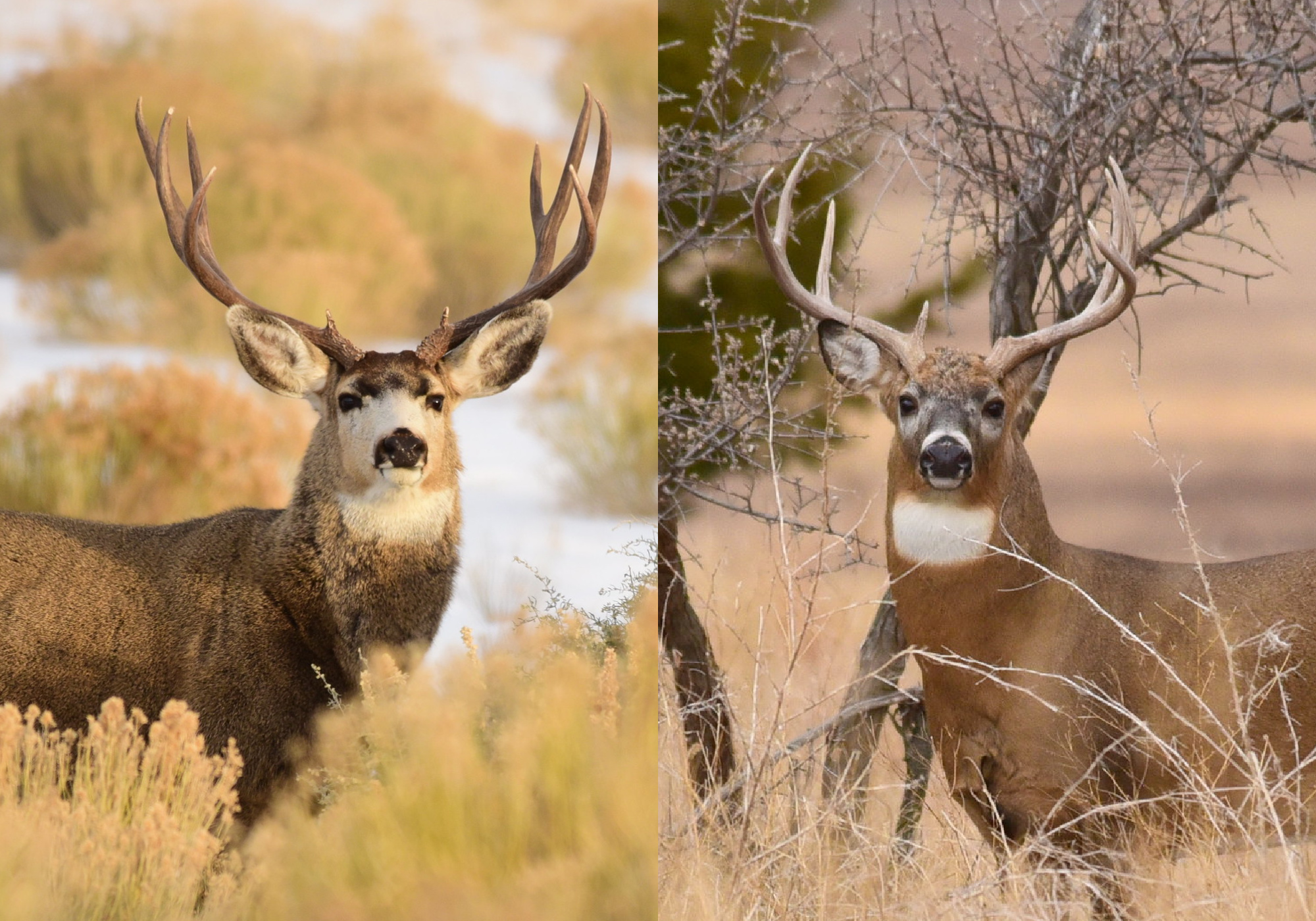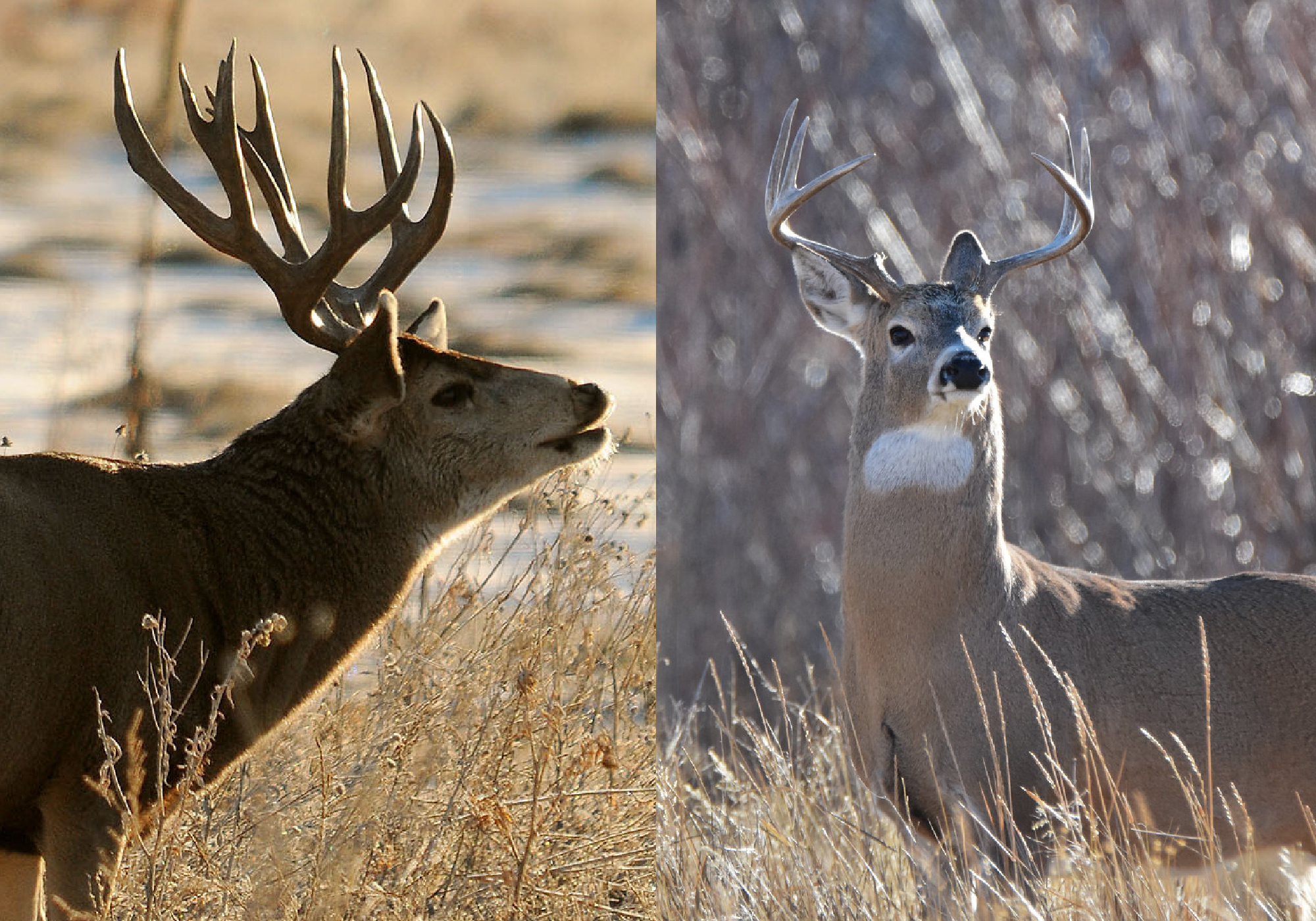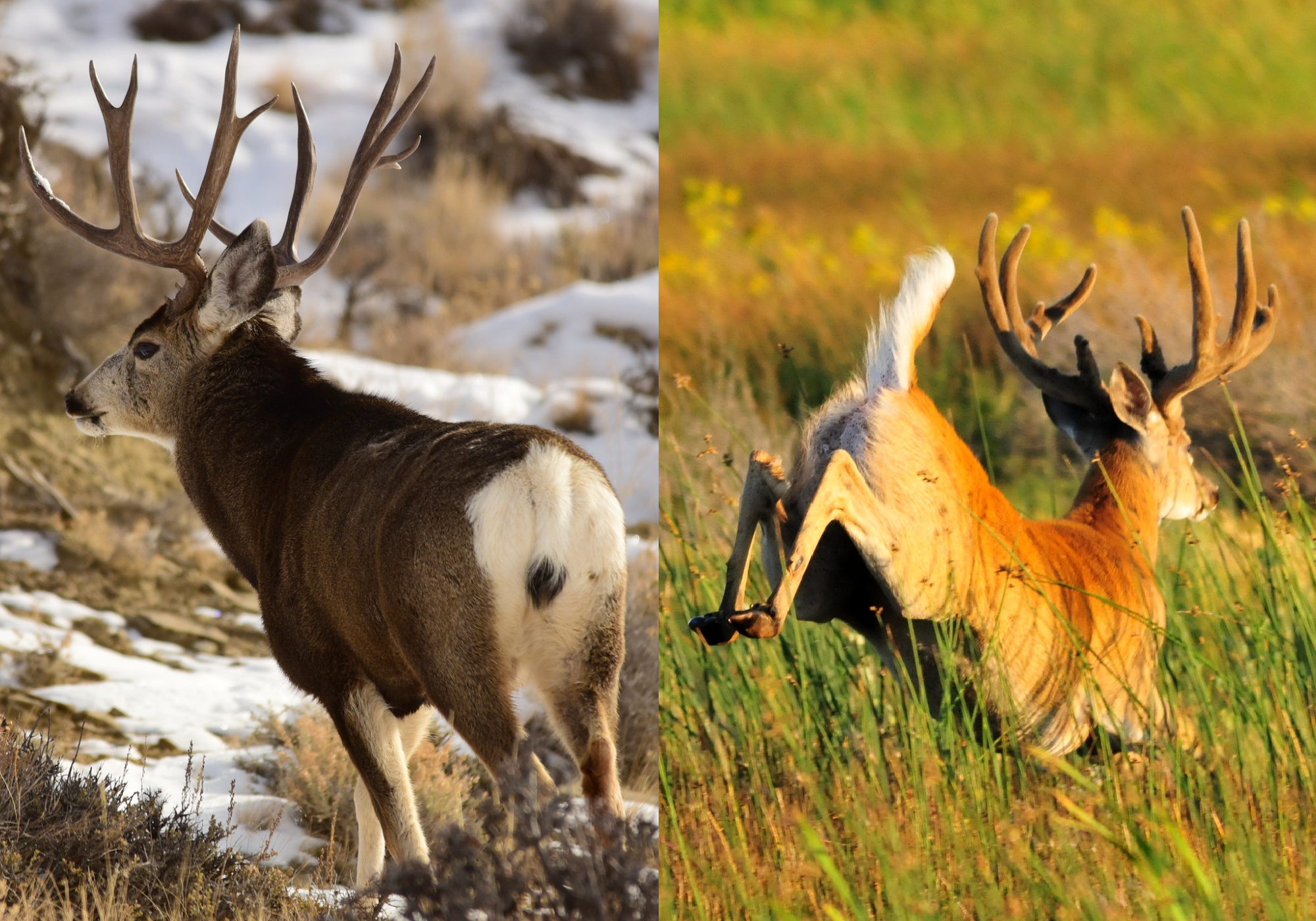Everyone who’s familiar with the two most popular deer species in the U.S. has their own method of telling a mule deer from a whitetail deer. If you happen to live in an area where the two species’ ranges overlap, then you’ve probably been playing the “mule deer vs. whitetail deer” game for a while. Maybe your brain works on autopilot and you can identify the species instantly. Or maybe you still struggle and need to double-check the tail—the most surefire identifier—every time you see a deer.
Here’s the problem with waiting for a tail sighting: If you see a muley’s white rump or a whitetail’s flag, it’s probably because that deer is running in the opposite direction. But you don’t have to wait that long to confirm which species is in your optics. Here are a few other ways to distinguish between the two. After all, a correct identification can end up being the difference between a memorable hunt and a citation for an illegal harvest.
Mule Deer vs. Whitetail Deer: The Face
Let’s assume a doe is either quartering toward you or standing broadside and looking your way. You can’t rely on tail or antlers to win the “mule deer vs. whitetail deer” game. How do you tell the two faces apart?
Mule deer usually have lighter fur that covers from their eyes to their noses, while whitetails have rings of light fur around their eyes and nose but darker fur on the rest of their faces. Both species have white patches on their throats, but the darker fur above the eyes of most mule deer can be a good tell. (This can look a lot like a unibrow, especially on bucks.) Whitetails’ faces tend to be slightly narrower, although that might be hard to notice unless you have a muley standing nearby for comparison.
Ultimately, look for a difference in color between the fur around the eyes and on the bridge of the nose. If the colors are uniform, you’re probably looking at a whitetail. If the fur is darker above the eyes than on the snout, it’s probably a mule deer.
Mule Deer vs. Whitetail Deer: The Ears
Let’s assume we’re still differentiating between antlerless deer. Anyone who has glassed deer in the West is intimately familiar with what a set of ears peeking through tall grass looks like. If you’re in an area where muleys and whitetails overlap, identifying deer by their ears alone is always a fun test.

Mule deer were actually named for their large ears, according to the Mule Deer Foundation. The lower edge of a muley’s ear is more curved, while the upper edge extends in a near-straight line from the skull plate at a roughly 120-degree angle. Whitetail ears are noticeably smaller. They are also more rounded and sit a bit higher on the head. When fully alert, they stand at closer to a 100-degree angle from the skull plate. In some instances, mule deer ears bottleneck where they attach to the head before fanning out, while whitetail ears tend to be a bit wider at the base. Both sets of ears have dark edges, but the color contrast in mule deer ears is sometimes more pronounced.
Mule Deer vs. Whitetail Deer: The Antlers
Now let’s assume you’re staring at a well-adorned buck and want to identify the species based on its antlers. Without a doubt, antlers are the one feature that varies the most from individual to individual, so sometimes a mule deer buck can have antlers that slightly resemble a whitetail’s, or vice versa. But there are plenty of structural consistencies in both species’ antlers that you can rely on to make the correct identification.

Classic, typical whitetail antlers have one prominent main beam on each side that curves around—often parallel to the ground on more mature deer—and toward their noses. Generally, you can trace that beam from the pedicle, or where the antler grows from the skull plate, to the very tip at the front of the rack. Tines shoot off this main beam at perpendicular or near-perpendicular angles.
Typical mule deer antlers, on the other hand, aren’t centered on the main beam. Instead, each side of the antler forks near the base, then forks again in the rear and front. The threshold for a mature mule deer is often (though not always) whether or not he has “both forks” on each side of his antlers. The antlers tend to grow more upward than forward. These Boone and Crockett antler scoresheets help illustrate the differences between typical whitetail and typical mule deer antlers.

Whitetail antlers are generally lighter in color, straighter, and more uniform. They also tend to be smaller on average than mule deer antlers. Mule deer fanatics love the bucks’ tendencies to grow nontypical racks full of drop tines, kickers, palmated tines, and other funky features. While nontypical whitetails are also fully capable of that kind of rack, they’re more likely to be missing or carrying an extra tine on one side than they are to have the messy, errant growth that nontypical mule deer have.
Read Next: The Biggest Nontypical Whitetails of All Time
Mule Deer vs. Whitetail Deer: The Body
In terms of color, both deer species are generally more red-brown in the summer and they lose their redness in the fall and winter as they turn gray. Mule deer get slightly more gray than whitetails do, but it’s really hard to notice that unless you see the two species standing side-by-side in the same light.

If the “mule deer vs. whitetail deer” game were about who would win in a fight, muleys might take the prize. Mule deer will get a little bigger than whitetails, especially leading up to the rut. Mule deer bucks can weigh around 330 pounds, about 30 pounds more than their heaviest white-tailed counterparts. Both species have white bellies and white on the insides of their legs.
The Telltale Tail
The tail should be the last body part you use to identify the species—especially if you don’t want to wait to see the deer running away from you. That said, identifying a calm deer by its rump is a useful way to differentiate between the species.

Mule deer have fluffy, cream-colored rumps with a short, white tail that ends in a black tuft. Sometimes you can see the faint edges of a white rear-end on a broadside view of the deer, but not always. Luckily, the white rump with the little black tuft is a pretty clear signal in mule deer country, so even if it’s walking away from you, it’s easy to pick out against a sagebrush sea from hundreds of yards away.
Read Next: The Biggest Threats to Mule Deer
Whitetail deer don’t reveal their namesake until they flag their flap-like tails. When that tail is down, the outside blends with the rest of the deer’s body color and just a few tufts of white hair might be visible around the edges. But when a whitetail decides to get gone, the tail raises straight up in the air to reveal the shock-white fur for which they’re named. By the time that happens, even if your chances of winning the “mule deer vs. whitetail deer” game go up, so do your chances of eating tag soup.

The Best Way to Tell Them Apart
There’s no right or wrong way to ensure what deer species you’re staring at. By checking out the whole picture and sizing up the face and ears first, followed by antlers (if there are any), you should be able to make an accurate identification without needing a glimpse at the tail. The more you deer hunt and the more deer you see, the better you’ll get at identifying mule deer versus whitetail deer.









